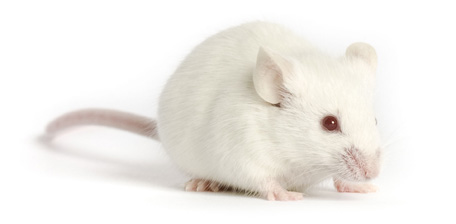Some day, revolutionary treatments for human knee, shoulder and hip injuries may be the result of research conducted with one of our JAX® Mice strains. Researchers at Oregon Health & Science University (OHSU) School of Medicine, Raymond Purves Bone and Joint Research Laboratories in Sydney, Australia, and the University of Melbourne, Murdoch Childrens Research Institute, Royal Children’s Hospital, Melbourne, Australia, have discovered that males of JAX® Mice strain MRL/MpJ (000486) can regenerate knee cartilage. This finding may help solve a major clinical problem in orthopedics — how to repair traumatic articular cartilage lesions.
Weakness in the knees
The research team was led by Dr. Jamie Fitzgerald, assistant professor of orthopedics and rehabilitation at OHSU. According to Fitzgerald, "Knee pain is one of the most common musculoskeletal complaints that bring people to their doctor. Human cartilage injuries heal poorly and can lead to cartilage degeneration and osteoarthritis. This is an enormous clinical problem. It is estimated that one quarter of the adult population will have some kind of arthritis by 2020." Not surprisingly, the National Football League Charities provided the grant to launch Fitzgerald’s study. Knee injuries are prevalent — sometimes career-ending — among professional athletes. Greg Oden missed his rookie season with the NBA’s Portland Blazers because of a cartilage injury, and golfer Tiger Woods was sidelined for two months after knee surgery to deal with damaged cartilage.
The self-healing mouse

Fitzgerald became interested in studying MRL mice while working at the Australian hospital in 2005. He and others noticed that MRL mice had the remarkable ability to heal ear hole punch wounds seamlessly, regenerating cartilage, hair follicles, skin and blood vessels without scarring. The objective of his most recent study was to assess whether MRL mice can repair or regenerate articular cartilage defects. So, he and his fellow OHSU researchers Andrea Herzka, M.D., and Cathleen Rich studied knee injuries in 150 mice. They introduced full thickness and partial thickness lesions into the trochlear groove articular cartilage of MRL mice and C57BL/6J (B6) controls. They assessed the wounds six and 12 weeks later using a histological scoring scheme and immunohistochemistry for articular cartilage markers (including proteoglycan, collagen II, and collagen VI). At 12 weeks post injury, partial thickness lesions had not healed in either strain. However, full thickness wounds in male MRL mice had healed exceptionally well, exhibiting abundant chondrocytes and an extracellular matrix with significantly more matrix proteoglycan and collagen II than did B6 controls.
Human applications
Dr. Chris Little, director of the Raymond Purves Bone and Joint Research Laboratories, and one of the scientists involved in the project, helped design the experiments and taught Fitzgerald and the OHSU team the surgical techniques used in the effort. He remarked: "The research we have published is an early but important step in unraveling the important pathways that will facilitate development of new treatments."
Researchers now have to determine why MRL mice can regenerate knee cartilage whereas other mice can't. Said Dr. Herzka, "If we can identify what genes or proteins are necessary for cartilage to heal, we can work toward finding similar genes and proteins in humans."
References
Fitzgerald J, Rich C, Burkhardt D, Allen J, Herzka AS, Little CB. 2008. Evidence for articular cartilage regeneration in MRL/MpJ mice. Osteoarthritis Cartilage 2008 Apr 30. [Epub ahead of print].
Media-Newswire press release. 2008. Cartilage that repairs itself? OHSU research reveals important clues. Media-Newswire.com July 8, 2008